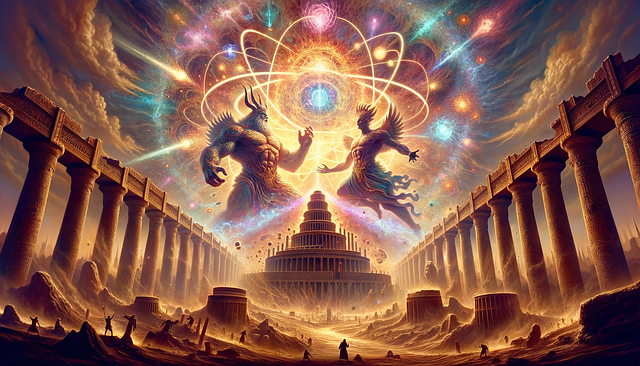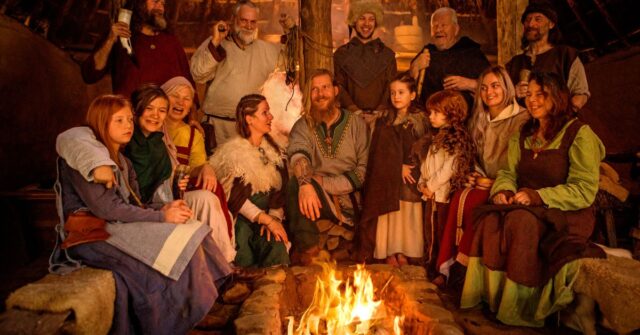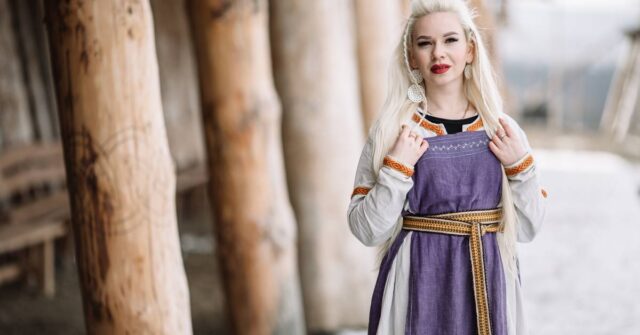Viking tattoos have long captured the imagination of history enthusiasts and tattoo lovers alike.
These ancient symbols and designs are more than just body art; they are windows into the values, beliefs, and lives of the Viking people.
In this blog post, we will delve deep into the historical background, symbolism, and modern interpretations of Viking tattoos to offer a comprehensive understanding of this fascinating subject.
Introduction
The Vikings, known for their seafaring prowess and warrior culture, have left an indelible mark on history. One of the intriguing aspects of their culture is the practice of body art.
Although direct archaeological evidence of Viking tattoos is sparse, historical accounts and cultural context suggest that tattoos played a significant role in their society.
This post explores the historical evidence, symbolism, and modern-day influence of Viking tattoos.


Historical Background of Viking Tattoos
Understanding the historical background of Viking tattoos requires piecing together evidence from various sources.
While no direct archaeological evidence of Viking tattoos exists, several historical texts provide insights into the practice of body art among the Norse people.
Evidence from Historical Accounts
One of the most compelling pieces of evidence comes from the 10th-century account of Ahmad Ibn Fadlan, an Arab traveler who described the Vikings he encountered along the Volga River.
He noted that the Vikings were tattooed from the tips of their fingers to their necks with dark green symbols.
This suggests that body art was widespread among the Norsemen and possibly held significant cultural meaning.
Role of Tattoos in Viking Society
Tattoos in Viking society likely served various purposes, from marking social status and achievements to offering protection through magical symbols.
Warriors might have worn tattoos as talismans to invoke the protection of gods or to commemorate victories in battle.
Tattoos could also signify allegiance to a particular clan or leader, reinforcing social bonds within the community.
Symbolism and Designs in Viking Tattoos
Viking tattoos were rich with symbolism, often drawing from Norse mythology and cultural motifs.
Each design carried specific meanings, reflecting the wearer’s beliefs, values, and aspirations.
Common Symbols and Their Meanings
There are many Viking symbols that are used across tattoos and in art. Let’s have a look at the most commonly used.


Valknut: The Warrior’s Knot
The Valknut, composed of three interlocking triangles, is one of the most recognizable Viking symbols.
It is often associated with Odin, the Allfather, and represents the transition between life and death, making it a powerful symbol for warriors who sought to honor their bravery and their connection to the divine.
Mjolnir: Thor’s Hammer
Mjolnir, the hammer of Thor, symbolizes strength, protection, and the power to overcome adversity.
It was a popular tattoo choice among Vikings, reflecting their admiration for Thor’s role as a protector of gods and humans.
Vegvisir: The Viking Compass
The Vegvisir, also known as the Viking compass, was believed to guide its bearer through rough waters and unfamiliar territories.
This symbol represents not only physical navigation but also the idea of finding one’s path in life.
Runes: Ancient Norse Alphabet
Runes were more than just letters; they were believed to hold magical properties.
Each rune had a unique meaning, such as protection, strength, or wisdom, making them popular choices for tattoos.
The runes could be used individually or combined to create powerful statements about the wearer’s beliefs and desires.
Animal Imagery and Mythical Creatures
Viking tattoos often featured animals and mythical creatures, each with its own symbolic significance.
These images were more than decorative; they conveyed deep cultural meanings and personal values.
Wolves and Ravens: Symbols of Odin
Wolves, such as Odin’s companions Geri and Freki, represented strength, loyalty, and the ferocity of warriors.
Ravens, particularly Huginn and Muninn, symbolized thought and memory, linking the wearer to Odin’s wisdom and insight.


Dragons: Power and Ferocity
Dragons in Norse mythology were formidable creatures symbolizing power, protection, and untamed nature.
Tattooing a dragon would signify the wearer’s strength and their connection to the mystical aspects of Viking culture.
Geometric Patterns and Knotwork
Intricate geometric patterns and knotwork were prevalent in Viking tattoos, reflecting the complexity and interconnectedness of Norse art.
These designs were not only visually striking but also carried meanings related to eternity, fate, and the interwoven nature of life.
Tattoo Techniques and Styles
The techniques and styles of Viking tattoos were as varied as their designs, influenced by the tools and materials available during the Viking Age.
Traditional Tattooing Methods
Viking tattoos were likely created using primitive tools and natural dyes.
Implements such as bone needles or sharp metal points would have been used to puncture the skin, while dyes derived from plants, ash, and other natural sources provided the ink.
This method, while rudimentary, allowed for the creation of detailed and meaningful body art.
Common Body Placements and Their Significance
The placement of tattoos on the body was also significant, with different locations carrying various meanings and connotations.


Arms and Shoulders
Tattoos on the arms and shoulders were highly visible and often symbolized strength and bravery.
These areas provided ample space for intricate designs, such as runes and animal imagery, showcasing the wearer’s dedication to their beliefs and heritage.
Back and Chest
The back and chest offered large canvases for elaborate tattoos, allowing for detailed scenes from Norse mythology or complex knotwork patterns.
These areas were ideal for tattoos representing protection, strength, and the wearer’s connection to their ancestors and gods.
Ribs and Thighs
Tattoos on the ribs and thighs, though more painful to create, were often chosen for their hidden nature.
These tattoos could symbolize personal beliefs, inner strength, and resilience, revealed only to those closest to the wearer.
Modern Interpretations of Viking Tattoos
Viking tattoos have found a resurgence in modern times, with many people seeking to connect with the ancient Norse culture through body art.
These tattoos have evolved while retaining their historical significance.


Contemporary Designs and Adaptations
Modern tattoo artists have embraced Viking designs, incorporating traditional symbols into contemporary styles.
These adaptations often blend ancient motifs with modern techniques, resulting in tattoos that are both historically rooted and visually appealing.
Whether it’s a minimalist rune or an elaborate sleeve featuring Norse mythology, these designs continue to captivate and inspire.
Cultural Sensitivity and Respect
When choosing a Viking tattoo, it’s important to approach the designs with cultural sensitivity.
Understanding the historical and cultural context of these symbols ensures that they are used respectfully and meaningfully.
Tattoos should honor the rich heritage of the Vikings without misappropriating or misrepresenting their culture.
The Legacy of Viking Tattoos
The legacy of Viking tattoos extends beyond their historical origins, influencing modern culture in various ways. These ancient symbols continue to inspire and resonate with people today.
Influence on Modern Culture and Media
Viking tattoos have permeated modern culture, appearing in movies, television shows, and video games.
Popular series like “Vikings” and “The Last Kingdom” have brought Norse imagery to the forefront, sparking renewed interest in Viking history and body art.
This cultural influence has helped preserve and celebrate the legacy of Viking tattoos.
Popularity in Contemporary Tattoo Art
The popularity of Viking tattoos in contemporary tattoo art speaks to their enduring appeal.
These designs are favored for their rich symbolism and aesthetic beauty, making them a popular choice for those looking to express strength, resilience, and a connection to their heritage.
Tattoo artists around the world continue to explore and innovate within the framework of Viking symbolism, keeping the tradition alive.
Debunking Myths and Misconceptions
Despite their popularity, several myths and misconceptions surround Viking tattoos.
It’s important to separate fact from fiction to appreciate the true history and significance of these designs.


Did All Vikings Have Tattoos?
Contrary to popular belief, not all Vikings had tattoos. While body art was likely common among certain groups, such as warriors and traders, it was not a universal practice.
Tattoos were often a personal choice, influenced by individual beliefs, status, and experiences.
Were Viking Tattoos Only Decorative?
Viking tattoos were far more than just decorative. They served as powerful symbols of identity, belief, and social status.
Tattoos could denote clan affiliation, commemorate battles, or invoke the protection of gods.
Understanding the deeper meanings behind these designs reveals the cultural significance they held for the Vikings.
Colors and Complexity of Viking Tattoos
While many imagine Viking tattoos as simple black designs, historical accounts suggest they could be quite intricate and possibly colorful.
The use of natural dyes allowed for a range of hues, and the detailed patterns reflected the skilled artistry of Viking tattooists.
These complex designs added layers of meaning and beauty to the tattoos.
Colors and Complexity of Viking Tattoos
While many imagine Viking tattoos as simple black designs, historical accounts suggest they could be quite intricate and possibly colorful.
The use of natural dyes allowed for a range of hues, and the detailed patterns reflected the skilled artistry of Viking tattooists.
These complex designs added layers of meaning and beauty to the tattoos.


Conclusion
Viking tattoos are more than just ancient body art; they are a testament to the rich cultural heritage of the Norse people.
From the detailed historical accounts to the intricate symbolism of their designs, these tattoos provide a window into the values, beliefs, and lives of the Vikings.
Modern interpretations continue to honor this legacy, keeping the spirit of Viking body art alive and well in contemporary culture.
Whether you’re a history enthusiast, a tattoo lover, or simply curious about Viking culture, understanding the depth and significance of these tattoos offers a fascinating glimpse into the world of the Vikings.











